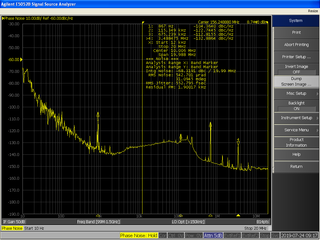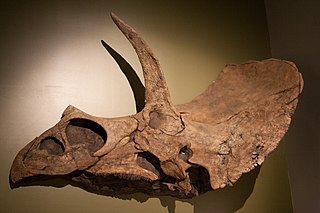Kota the Triceratops was an animatronic toy dinosaur made by Hasbro and Playskool. It is modeled after a triceratops, and intended for children aged 3 to 6.
The toy debuted at Toy Fair New York in February 2007, building on the reception of Ugobe's earlier Pleo robotic dinosaur toy, and went on sale in October 2007 for approximately US$300 as listed by the company website. A review by IEEE Spectrum indicated that it had 11 sensors over its body to sense touch and pressure, and made appropriate noises (like roars) or movements (like tail-wagging) in response. It had some functionality to accept a folded "leaf" food, and move its jaw and make appropriate chomping noises.

In signal processing, phase noise is the frequency-domain representation of random fluctuations in the phase of a waveform, corresponding to time-domain deviations from perfect periodicity (jitter). Generally speaking, radio-frequency engineers speak of the phase noise of an oscillator, whereas digital-system engineers work with the jitter of a clock.

Triceratops is a genus of chasmosaurine ceratopsian dinosaur that lived during the late Maastrichtian age of the Late Cretaceous period, about 68 to 66 million years ago in what is now western North America. It was one of the last-known non-avian dinosaurs and lived until the Cretaceous–Paleogene extinction event 66 million years ago. The name Triceratops, which literally means 'three-horned face', is derived from the Greek words trí- meaning 'three', kéras meaning 'horn', and ṓps meaning 'face'.

Sinclair Oil Corporation was an American petroleum corporation founded by Harry F. Sinclair on May 1, 1916. The Sinclair Oil and Refining Corporation amalgamated the assets of 11 small petroleum companies. Originally a New York corporation, Sinclair Oil reincorporated in Wyoming in 1976. The corporate logo featured the silhouette of a large green sauropod dinosaur, based on the then-common idea that oil deposits beneath the earth came from the dead bodies of dinosaurs.

Torosaurus is a genus of herbivorous chasmosaurine ceratopsian dinosaur that lived during the late Maastrichtian age of the Late Cretaceous period, between 68 and 66 million years ago, though it is possible that the species range might extend to as far back as 69 million years ago. Fossils have been discovered across the Western Interior of North America, from as far north as Saskatchewan to as far south as Texas.
A cognitive radio (CR) is a radio that can be programmed and configured dynamically to use the best channels in its vicinity to avoid user interference and congestion. Such a radio automatically detects available channels, then accordingly changes its transmission or reception parameters to allow more concurrent wireless communications in a given band at one location. This process is a form of dynamic spectrum management.

Ceratopsia or Ceratopia is a group of herbivorous, beaked dinosaurs that thrived in what are now North America, Europe, and Asia, during the Cretaceous Period, although ancestral forms lived earlier, in the Jurassic. The earliest known ceratopsian, Yinlong downsi, lived between 161.2 and 155.7 million years ago. The last ceratopsian species, Triceratops prorsus, became extinct during the Cretaceous–Paleogene extinction event, 66 million years ago.
Dino-Riders is an animated television series that first aired in 1988. The cartoon was primarily a promotional show to launch a new Tyco toy line. Only fourteen episodes were produced, three of which were produced on VHS for the United States. The show aired in the U.S. as part of the Marvel Action Universe programming block.

Nedoceratops is a controversial genus of ceratopsid dinosaur from the Late Cretaceous period Lance Formation of North America. It is known only from a single skull discovered in Wyoming. Its status is the subject of ongoing debate among paleontologists: some authors consider Nedoceratops a valid, distinct taxon, while others consider it to be an unusual specimen of Triceratops.

Extreme Dinosaurs is an American animated series produced by DIC Productions, L.P. and Bohbot Entertainment in 1997 based on a 1996 toy line from Mattel. This show is a spin-off of Street Sharks.

The Truth About Killer Dinosaurs is a two-part BBC documentary film, directed by Bill Oddie, in which a group of men test out dinosaur weapons, using studies. The first episode determines the winner of a battle between Tyrannosaurus and Triceratops, and the second compares the strength of an Ankylosaurus and Velociraptor. The episodes were broadcast on BBC 1 in August and September 2005. In the U.S., The Truth About killer Dinosaurs was also known as Dinosaur Face-Off.

Dinosaur King is a Japanese card-based arcade game from Sega that uses similar gameplay mechanics to Mushiking. The game was revealed in JAMMA 2005. A Nintendo DS version was also later released.

Tyrannosaurus rex is unique among dinosaurs in its place in modern culture; paleontologist Robert Bakker has called it "the most popular dinosaur among people of all ages, all cultures, and all nationalities". Paleontologists Mark Norell and Lowell Dingus have likewise called it "the most famous dinosaur of all times." Paleoartist Gregory S. Paul has called it "the theropod. [...] This is the public's favorite dinosaur [...] Even the formations it is found in have fantastic names like Hell Creek and Lance." Other paleontologists agree with that and note that whenever a museum erects a new skeleton or bring in an animatronic model, visitor numbers go up. "Jurassic Park and King Kong would not have been the same without it." In the public mind, T. rex sets the standard of what a dinosaur should be. Science writer Riley Black similarly states, "In all of prehistory, there is no animal that commands our attention quite like Tyrannosaurus rex, the tyrant lizard king. Since the time this dinosaur was officially named in 1905, the enormous carnivore has stood as the ultimate dinosaur."

Eotriceratops is a genus of herbivorous ceratopsian dinosaurs which lived in the area of North America during the late Cretaceous period. The only named species is Eotriceratops xerinsularis.
In digital communications, chirp spread spectrum (CSS) is a spread spectrum technique that uses wideband linear frequency modulated chirp pulses to encode information. A chirp is a sinusoidal signal whose frequency increases or decreases over time.

Escape is maze video game for the ZX Spectrum developed by New Generation Software and published in 1982.
Xtractaurs is a line of toys by Mattel. Introduced in 2009, the brand is a fusion of regular action figures with an online game. It involves taking a dinosaur and extracting "DNA" samples from the dinosaur and analyzing it on your computer, similar in a way to the book and film Jurassic Park. If you own multiple dinosaurs and have extracted samples from all of them, you can create a genetically engineered hybrid on the computer to battle the "Megavores", ancient reawakened dinosaurs that share qualities with your dinosaur. Each dinosaur you purchase has a special ability, and combining them makes a fierce fighting animal. This encourages the fusion of certain samples even more.

The feeding behaviour of Tyrannosaurus rex has been studied extensively. The well known attributes of T. rex are often interpreted to be indicative of either a predatory or scavenging lifestyle, and as such the biomechanics, feeding strategies and diet of Tyrannosaurus have been subject to much research and debate.

Toy Story That Time Forgot is an American computer-animated Christmas television special, produced by Pixar Animation Studios that aired on ABC on December 2, 2014. Written and directed by Sam & Max creator Steve Purcell, the special was produced by Galyn Susman. Michael Giacchino composed the music for the special. Most of the regular cast from the Toy Story series reprised their roles, including Tom Hanks as Woody, Tim Allen as Buzz Lightyear, Kristen Schaal as Trixie, Wallace Shawn as Rex, Timothy Dalton as Mr. Pricklepants, Don Rickles as Mr. Potato Head, and Joan Cusack as Jessie, with Kevin McKidd and Emma Hudak joining as new characters Reptillus Maximus and Angel Kitty, respectively. This was Rickles' final TV special role before his death on April 6, 2017, and was the last Toy Story production for five years until the release of Toy Story 4 on June 21, 2019. The special received critical acclaim.

This timeline of ceratopsian research is a chronological listing of events in the history of paleontology focused on the ceratopsians, a group of herbivorous marginocephalian dinosaurs that evolved parrot-like beaks, bony frills, and, later, spectacular horns. The first scientifically documented ceratopsian fossils were described by Edward Drinker Cope starting in the 1870s; however, the remains were poorly preserved and their true nature was not recognized. Over the next several decades, Cope named several such genera and species. Cope's hated rival, Othniel Charles Marsh, also described ceratopsian remains. In 1887, Marsh mistook a Triceratops horn for one belonging to a new species of prehistoric Bison. Marsh also named the eponymous genus Ceratops in 1888. The next year, he named the most famous ceratopsian, Triceratops horridus. It was the discovery of Triceratops that illuminated the ceratopsian body plan, and he formally named the Ceratopsia in 1890.

Big John is a fossilized Triceratops horridus skeleton discovered in South Dakota's Hell Creek geological formation in 2014. It is the largest known Triceratops skeleton, according to the team that assembled the fossil. Big John's 2021 auction price of €6.6 million made it the most expensive Triceratops skeleton; its high price signaled increasing demand for dinosaur fossils among private collectors and prompted discussion about the drawbacks of private fossil ownership for scientific research.